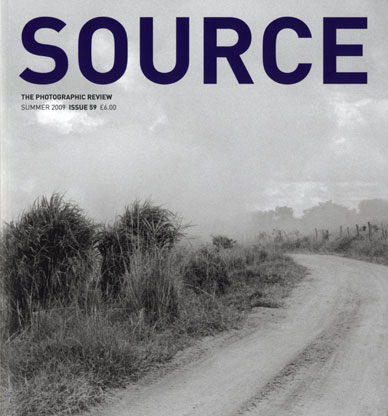rogerpalmer.info
Photographs | Installations | Video | Books & Catalogues | Exhibitions | Texts | Contact | Links
Text:
Source Magazine, Summer 2009 |
 |
Richard West: Where were these pictures taken? Could you say something about the title, About Turning ? The word 'tropic' has its origins in Latin and Greek from the word tropos which means 'turning'. An ancient belief had it that the sun, when it made its journey north through the Tropic of Cancer or south through the tropic of Capricorn, would turn back once it reached that most northerly or southerly point. I wanted to add to that something I had been thinking about, which was the experience of the artist who makes photographs that are on film and therefore not visible until they are processed. One operates the camera to create, let's say, each invisible exposure, and there is a certain point when one has to turn away from the act of making the picture, retaining a memory of what it is that you are turning away from, let's call it an afterimage. So, I am conscious that when I am making this work that I am collecting a series of images on film but I am also collecting these memories, or afterimages of each session. I want to encourage a viewer to also be conscious of this act of turning away from the work. We all do it with every picture or experience we have, we have to leave it. One of the key experiences for me as a young artist was to be aware that you didn't have to be standing in front of the art work for it have an effect on you. Long after you have turned away it could still be functioning, but in a quite different way. So I was trying to make some kind of equation between the ancient belief of the sun turning at the tropic, the artist turning away from the exposure of the film and the viewer turning away after encountering the work. Presumably some part of your process of making the work is editing, you don't use all of the exposures that you make? It always takes me quite a while to get my concentration going so I take a lot of photographs that I am almost certain that I am not going to use. Sometimes the moments that I get excited about when I am in a particular place taking pictures turn into absolutely nothing as soon as I see them as images on a contact strip. The pictures that you put together often have similar formal qualities, are you trying to suggest a common way of reading those pictures? What I'm really wanting you to do is to look at how photography pulls all those things together on the same picture plane and creates complex questions about representation and misrepresentation. There is a place called Bar Tropical - I think it just says '...cal' in the picture - and it's painted with, let's call it, a Caribbean beach complete with palm trees. This Bar Tropical is, in fact, about 10km from the actual Tropic. In front of the wall painting is a real palm tree, and in the picture, one of the branches of that tree connects up with a painted representation of a palm tree in the pictorial space that the photograph constructs. It's those kinds of complexities that I'm particularly interested in. There seem to be a different set of concerns in each set of pictures, from railway lines to pictures of roads leading into obscurity. You have a very broad range of formal approaches. The idea of the project creates space for me as a kind of glue to hold a set of pictures together. This contextual framework allows me to be quite flexible in the kinds of pictures that I make; if I take one picture of a railway line it's like a chance encounter in a particular place, but when you have three of them you know there is another kind of process of thinking and making at work here. Having the tight structure, of where to go and when to go, and groups of three pictures, allows me to be a bit more relaxed about the ways the pictures function and what it is that they represent from those places. In a way what we have is a kind of palette of different ways of viewing the world, each little set suggests a different approach. What they all come back to is the way that the medium - in my case the 35mm, standard lens, handheld camera, 400 ASA film and a particular kind of printing process - standardises the photograph from which we then can extract these references to the world at large. Ultimately, they are about the hopelessness of trying to represent places. I don't think they say anything about Australia, Namibia or Brazil, which is why I don't bother to say which is which. They are much more about bringing together different fragments of the world into one location, and that location is the photographic picture plane. So in a way they are about pictureness rather than about place? Yes, I think they are about pictureness. If you were from Mount Isa in Australia you might recognise the black and white blobby wall of the local butcher shop, but the pictures don't really do anything other than represent circumstances in a completely ordinary place where nothing is happening. They are more about pictureness than place, they actually might be more about placelessness than place.
|